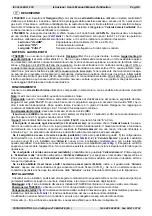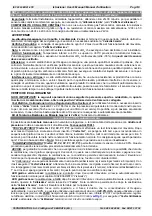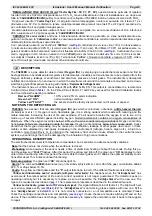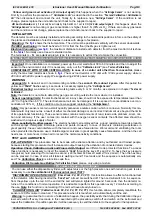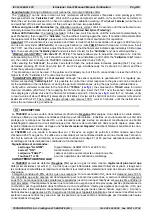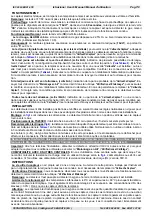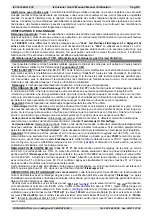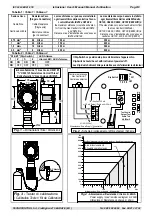
IST-2293.EO01.01/C
Istruzione / User’s Manual / Manuel d’utilisation
Pag.4/9
TECNOCONTROL S.r.l. Via Miglioli 47 SEGRATE ( MI )
Tel: 02/26 92 28 90 Fax: 02/21 33 734
“REGOLAZIONE FINE USCITA IN mA”(
Codice Reg.Fine
: F2, F1, F1, F2):
questa funzione permette di regolare
l’uscita in mA di ± 0,32mA corrispondente a ± 0,5% O
2
ma va utilizzata solo in fase di installazione e se, dopo aver
fatto la “
CALIBRAZIONE IN ARIA
”(pulita), la centrale cui è collegato il TS293EO indica un valore diverso da 20,9%O
2
.
Dopo aver inserito il “
Codice Reg. Fine
”, il Led giallo inizia a lampeggiare, il valore si aumenta con il tasto F1 e si
diminuisce con F2. Per confermare, tenere contemporaneamente premuti i due tasti F1 ed F2 per 2 secondi e do-
po controllare che il Led giallo rimanga spento.
Questa operazione può essere usata anche se è acceso il Led giallo, ma se la concentrazione di O
2
è inferiore a
20,6 o superiore a 21,2 prima eseguire la “
CALIBRAZIONE IN ARIA
”.
“VERIFICA”(
non serve codice
):
anche se il funzionamento del sensore è garantito, se viene periodicamente ese-
guita con successo la “
Calibrazione in Aria
”, è comunque possible controllare la corretta risposta del rilevatore al gas
utilizzando la miscela di gas sopra indicata.
Con i puntali del volmetro sui Test-Point “
TESTmA
”, (
vedi fig.2
) controllare che ci siano circa 174 mV in funzionamen-
to normale in aria pulita (20,9% O
2
) [
ovvero che l’uscita in mA sia 17,4 mA circa
].
Poi infilare il TC011 sul portasensore, re-
golare il riduttore della bombola in modo che il flussometro indichi circa 0,3 l/min (
vedi fig. 3
).
Controllare che il vol-
metro, raggiunga
in 2÷3 minuti
un valore di circa
143mV
[
ovvero che l’uscita in mA diminuisca fino a circa 14,3 mA e la centrale,
cui è collegato il rilevatore, indichi circa 16% (±0,2)
].
Terminata la “
Verifica
”, chiudere la bombola e togliere il TC011.
Atten-
dere 3-5 minuti
per tornare alle condizioni di funzionamento normale.
DESCRIPTION
The
TS293EO
is a gas detector able to detect
Oxygen (O
2
)
by employing an electrochemical sensor and find its
best application in centralized alarm systems for laboratories, industries and environments to be protected from the
Oxygen deficiency, leakage or enrichment and also from presence of inert gases. The instruments is flameproof
certified and comprise of an enclosure in which the electronic circuit and the terminals are mounted and a down-
ward facing cylindrical sensor housing with inside a “
Replaceable Cartridge Sensor
”.
The instrument has a 4÷20mA linear output (
S
) with
25.0 % O
2
F.S. This output is connectable to a remote Gas
Central Unit as listed in
Table 1
.
On the Printed Circuit Board, F1 and F2 key are used for Test and Calibration routine
and 3 Led shows the working conditions:
Red Led "ALARM":
19,5% and 22,5% O
2
alarm indication
Green Led "ON":
normal working condition
Yellow Led "FAULT":
the sensor should be faulty, disconnected, out of scale or expired.
NOTES ON THE DETECTED GAS
TS293EO
has a sensor that can detect
Oxygen (O
2
)
gas which is colourless, odourless,
a little heavier than air
(
its density as to air is 1.1
). Oxygen is not a flammable gas, it is a strong oxidant which reacts with reducing and fla-
mable materials, increasing the risk of fire and explosion. We all need to breathe the oxygen in air to live. Air is
made up of several different gases including oxygen. Normal ambient air contains an oxygen concentration of
20.9% v/v. When the oxygen level dips below 19.5%v/v, the air is considered oxygen-deficient. Oxygen concentra-
tions below 16%v/v are considered unsafe for humans. Oxygen concentrations below 6%v/v cause death. Consi-
dered that the Oxygen decreasing may be caused by combustion, leakage of other gases (toxic and / or flam-
mable) or also displaced by inert gases increasing in the environment (nitrogen, helium, argon etc.). A high con-
centration, more than 24%v/v O
2
is irritating to the respiratory tract and can cause effects on the central nervous
system, eyes and lungs that can be damaged by the inhalation of high concentrations.
OPERATIONAL DESCRIPTION
The electrochemical sensor is temperature compensated, but is sensitive to extreme humidity variations.
Note
that the Led are not visible when the enclosure is closed.
Preheating
: when powered, the sensor needs a time of preliminary heating of about 60 seconds. During this pe-
riod the yellow Led “
FAULT
” flashes. After this period, the yellow Led light off, the green Led “
ON
” illuminates to indi-
cate normal functioning. After this period the unit is able to detect gas even if it attains the optimum stability condi-
tions after about 15 minutes continual functioning.
Normal operation
: the green Led “
ON
” should be light on.
Alarm:
The red Led (
ALARM
) illuminates (
only if it be activate by Dip-Switch no.1 set to ON
) if the gas concentration attains
22,5 % or drops below 19,5%
Faults:
the yellow Led illuminates and the "
S
" output falls down to 0mA. (The different faults are listed below).
Yellow Led illuminates each 4 seconds (
with green Led activate
):
this happens when the “
Cartridge Sensor
” has
overcome its theoretical period of life and its correct operation is not longer guaranteed. The detector keeps on
operating normally but it is necessary to replace, as soon as possible, the “
Cartridge Sensor
” with a new one. The
type to be required is described on
pag.
1
. The replacement procedure is described in the attached manual.
Yellow Led activate, green Led off (
0 mA output signal
):
this signal different kind of faults.
1)
The Dip Switch set
up is wrong, please verify (
see Table 2
).
2)
The “
Cartridge Sensor
” is not working, please replace with new one.
3)
If a
new
“
Cartridge Sensor
” is instalLED or it is not correctly connected or a not compatible one is mounted. Please
check the cartridge connections and compatibility (
see on pag. 1
) these checks are made switching off and on the
device.
If the condition does not change, it will be necessary to replace the unit and/or send it back to the supplier
to repair.


